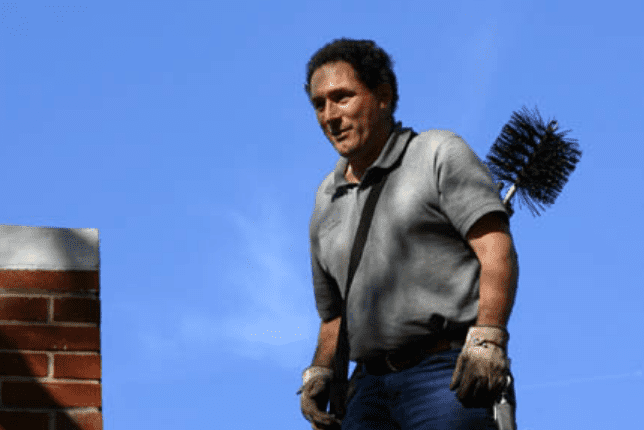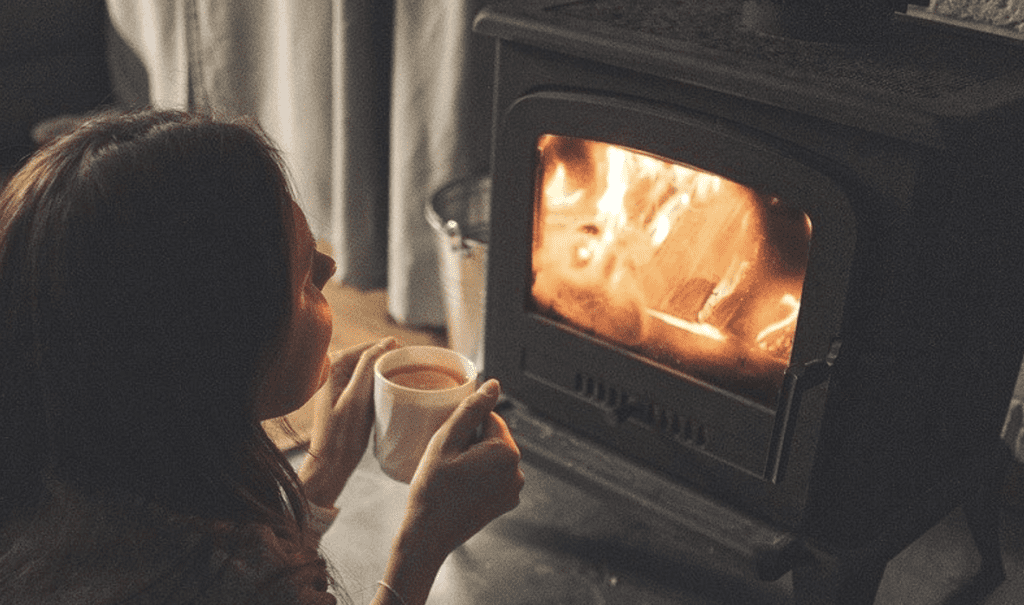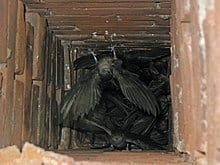
One of the best things about winter is curling up next to a roaring fireplace. But maintaining a wood-burning fireplace is a lot of work, and failure to keep your chimney clean has serious consequences.
You can tell it is time to clean your chimney if fires are hard to start or aren’t burning like they normally do.
A campfire odor when you haven’t burned in a few days is another sign.
Look for particles falling down from your chimney into the firebox. You might notice oily spots on the walls of the fireplace.
Smoke coming into the house or not being able to feel air flowing through the chimney are more signs. You also might notice signs of animals in your chimney.
Having a dirty damper is another sign that you need to clean your chimney.
Being aware of signs that your chimney needs to be cleaned makes your home safer. Continue reading to learn more about identifying a chimney that needs cleaning and about chimney cleaning basics.
Signs That Your Chimney Needs Cleaning:
Fires Are Hard To Start

A build-up of soot and creosote in the flue causes poor airflow and makes it difficult to start a fire. If you do your fire-starting routine only to have it sputter out, it could be time to clean your chimney.
The damper is a flap that closes the chimney when you pull a handle. Closing the damper stops warm air from escaping out the flue.
The damper should be clean. If a black or sticky substance coats the damper, it is time to clean your chimney.
Smells Coming From The Fireplace
A campfire odor coming from the fireplace when there hasn’t been a fire burning for more than a day is a sign of a dirty chimney. You shouldn’t notice any smokey odors if you haven’t burned in your fireplace for more than a day. The odors could be from a build-up of creosote and you should have your chimney inspected.
Wet or Oily Looking Spots
When creosote builds up, it has oils in it that can drip down onto the inner walls of your fireplace. If you start to notice wet spots, that could be creosote oil, and you should have your chimney cleaned.
Fires That Aren’t Burning Well
If you are used to having a roaring fire that stays lit all night, then it suddenly seems hard to get the same effect; it could be a build-up in the chimney. If you are making your fires the same way, but they are not burning as well, you should have your chimney inspected.
Smoke Comes Into The House
It is normal for a little smoke to come into the house while lighting a fire. If you notice a lot of smoke or smoke coming in after the fire is burning, that could indicate a blockage in the chimney.
Animals In The Chimney

Animals might enter the chimney in the warm season because it makes a good hiding place. Birds can build nests in the chimney, which would catch fire when you have your first fire.
Signs of animals in your chimney include:
- Animal noises like chirping, squealing and scratching.
- Animal droppings in the fireplace.
- Bad smells from a dead animal or feces.
No Airflow Through The Chimney
When the damper is open, air should be able to flow through the chimney. Either wind coming from outside, or warm air rising should create an air current in the chimney that you can feel with your hand.
Particles Fall Down The Chimney
If you see or hear debris falling down your chimney, it is a sign that there is a lot of buildup. This means it is time to clean your chimney.
Why Do Chimneys Get Dirty?
Chimneys get dirty because not all of the wood burns in the fire. Smoke is unburnt particles of wood. The unburnt particles of wood have sticky oils called creosote.
The creosote sticks to the flue walls and builds upon itself. Eventually, the opening for the smoke to leave the house gets smaller and smaller. The three phases of creosote buildup are:
- Light and full of air; easily removed with a chimney brush.
- Sticky and flaky; can be removed with a chimney brush but it takes more effort.
- Hard and tar-like; the third stage is called glaze, and it could be impossible to remove with only a chimney brush.
Can I Prevent Creosote From Dirtying My Chimney?
Your burning habits affect how much creosote builds up in your chimney. It would be difficult to completely prevent creosote build-up, but you can take steps to have less creosote.
Burning wet or green wood leads to more creosote. Using properly seasoned firewood means less creosote.
Having air leaks in your chimney also makes more creosote build-up. The cool air makes the creosote condense inside of your chimney. Repairing any air leaks in your chimney prevents creosote build-up.
What Happens If I Don’t Clean My Chimney?

The creosote that builds up in your chimney is flammable. If it catches fire, your life and your house are at risk.
Chimney fires burn at 2000 degrees Fahrenheit. They quickly spread from the chimney to the rest of the house.
Chimney fires are one of the leading causes of house fires in homes with fireplaces. Cleaning your chimney is simple maintenance that keeps you safe.
How Often Should I Clean My Chimney?
The National Fire Protection Association recommends annual chimney cleaning. It is just not worth the risk of putting off cleaning.
The Chimney Safety Institute of America recommends cleaning your chimney when soot builds up 1/8 inch. This is about a year’s worth of buildup, depending on your burning habits.
Can I Clean My Own Chimney?
You can clean your own chimney, but you need to be aware that it means buying special equipment and working at dangerous heights. Chimneys that are cleaned regularly are easier to clean.
Hiring a professional chimney sweep is the best choice for chimney cleaning.
If it has been a long time since your chimney was cleaned, the creosote that’s built up will make it hard to clean. If you don’t know the last time your chimney was cleaned or it has been many years, it is best to have a professional do the cleaning for you.
Once your chimney is cleaned by a professional, you can take on the yearly chimney cleaning. After a professional removes the creosote, you will have an easier time maintaining your chimney.
How Do I Clean My Chimney?
You need a chimney brush to clean your chimney. They have a circular, stiff, wire-bristled brush and a long, collapsable handle that reaches through your entire chimney. The brush needs to be the right size for your flue.
Here are the steps to clean your chimney:
- Tape off your fireplace on the inside so soot you knock off doesn’t fly into your house.
- You need to access the top of your chimney with a ladder and secure a rope and safety harness to prevent falling.
- Work the wire brush down the chimney, scrubbing the soot off the walls as you go down. Brush until you don’t feel any resistance. Use a flashlight to look down into the chimney and be sure it is getting clean.
- Clean the soot that falls into the fireplace; you can compost it or put it in the trash.
Cleaning a chimney is dirty work. You should wear old clothes, a facemask and eye protection. You can also use a shop vac with a long hose to suck out debris as you sweep the chimney.
How Effective Are Chimney Cleaning Logs?
Chimney cleaning logs also called creosote sweeping logs, make your chimney easier to maintain when used properly. They do not replace a yearly chimney sweep, but they make cleaning easier.
Cleaning logs are not necessary if you have recently had your chimney cleaned. They are most effective if you have some built-up, glazed creosote in your chimney.
If your chimney has a thick buildup of creosote, chimney cleaning logs might be the only way to break it up. After using the cleaning log, you will still need to clean the chimney with a chimney brush.
How Does A Chimney Cleaning Log Work?
Chimney cleaning logs contain chemicals that rise up your chimney and stick to creosote. The chemicals help dry out the creosote, making it easier to remove.
Some pieces of soot and creosote might fall down your chimney after burning a chimney cleaning log. The chemicals stick to the creosote and keep working for up to two weeks to dry out the creosote.
If you burn a fire each day, you should use a cleaning log twice per burning season. For less frequent fireplace users, once per burning season is fine.
Chimney Cleaning For Gas Fireplaces
Gas fireplaces don’t leave creosote in a chimney. Your chimney still needs to be inspected and cleaned every year.
Gas is clean-burning, but there is still some residue left on the inside of the chimney. Having an annual inspection and cleaning ensures that your chimney works the best it can.

